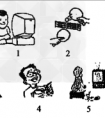听对话和独白回答问题。听第一段对话,回答1至2小题。 1.How long did Hans spend traveling? [ ]A.Two weeks. B.Four weeks. C.Six weeks.2.What was the weather like-九年级英语
题文
| 听对话和独白回答问题。 |
| 听第一段对话,回答1至2小题。 |
| 1.How long did Hans spend traveling? |
|
[ ] |
| A.Two weeks. B.Four weeks. C.Six weeks. |
| 2.What was the weather like in England when Hans was there? |
|
[ ] |
| A.Hot. B.Cool. C.Foggy. |
| 听第二段对话,回答3至5小题。 |
| 3.What is the relationship between the two speakers? |
|
[ ] |
| A.Classmates. B.Teacher and student. C.Wife and husband. |
| 4.Why did Mary call Mike? |
|
[ ] |
| A.Because she wanted Mike to meet her new friends. B.Because she wanted Mike to take part in a party. C.Because she wanted to go for a trip with Mike. |
| 5.When would the party begin? |
|
[ ] |
| A.This Friday. B.This Saturday. C.It is not decided. |
| 听一段独白,回答6至10小题。 |
| 6.Where should you go if you want to buy a jacket for your brother? |
|
[ ] |
| A.To the third floor. B.To the second floor. C.To the first floor. |
| 7.Which of the following can you buy on the second floor? |
|
[ ] |
| A.A fridge. B.A storybook. C.Shoes. |
| 8.What does the speaker ask the passengers to take before they leave the bus? |
|
[ ] |
| A.Take the tickets with them. B.Take the expensive things with them. C.Take some chocolates with them. |
| 9.When do the travelers get to the shopping center? |
|
[ ] |
| A.At about 1:00 p.m.. B.At about 3:00 p.m.. C.At about 4:00 p.m.. |
| 10.Where do you think the speaker is speaking? |
|
[ ] |
| A.On a bus. B.At a bus stop. C.In the shopping center. |
答案
| 1-5: ABABC 6-10: ABBBA |
据专家权威分析,试题“听对话和独白回答问题。听第一段对话,回答1至2小题。 1.How lon..”主要考查你对 听力 等考点的理解。关于这些考点的“档案”如下:
听力
考点名称:听力
- 听力:
常作为一种考试题型,目的在于考察应试者对英语语言的把握,考察考生对英语日常交流的理解能力;
通常有听对话选择答案、听句子默写关键字词几种形式。 英语听力中的精听和泛听:
精听
精听的目的是系统学习语音、积累小词习语、句型表达和背景,可采用下面两种方式:
一是模仿法:精听一段文字,然后参考听力原文,跟读模仿到语音、语调分毫不差,甚至录下自己的发音和原音比较,逐段纠正语音、语调。
二是听抄法:又称四遍法,第一遍听大义;第二遍利用复读机或软件尽量听写出每句话,但不要参考听力原文;第三遍和听力原文比对,找出听不懂的原因;第四遍翻译或者背诵。
泛听
泛听目的有二:一是练习捕捉大意,让理解单位从“词汇”到“句子”再到“大意”;二是熟悉语速和语境,既真实英语的使用环境。切忌把泛听当精听。战胜“细节完美主义”的办法是重大意而非细节,重内容而非语言,重正在听的内容而非听过的内容。初中英语听力技巧:
听力题型大致有以下几种:
①听短句选出相应的应答语;
②听对话及问题选出正确的答案;
③听短文及问题选出恰当的答案或图画;
④听句子或短文填词。
一、听力测试的应试技巧:
1. 放松情绪,集中精力。
放松情绪和集中精力并不矛盾,过于紧张的情绪有碍于考生的正常发挥;反之,放松一下情绪,比如考前的深呼吸或闭目片刻都可使考生的心情平静下来,很容易进入答题状态。
2. 抓紧时间,提前审题。
提前审题的好处在于它可以帮助我们预知要听的重点,提高捕捉信息的准确度,这样降低了听力材料的难度。
3. 沉着答题,遇难不慌。
①在审题预测的基础上进行听力预测。
例如:看到A : Yes , I mind. B : Yes , I do. C. Not atall. 就要立即想到,此题关键要考“Do/ Wouldyou mind. . . ?”的回答, 应马上想到回答是“Not at all . ”,
“Of course not . 或“I’m sorry.But you can’t do it . ”
②听力的时间是预先设定的,不可人为控制,因此要养成抢记内容的能力。
听力材料中的一些数字、地名或人名等细节信息,需借助笔记。
做笔记时只要记主题句和关键词,特别是对那些听到一时拿不准、写不出的词要学会用音标作快速记录,这样可以在录音结束后,为自己创造追忆的条件。
另外,在做题过程中如遇到听不懂的,要舍得果断放弃,集中精力,紧迫磁带速度走,切不可瞻前顾后,一误再误。
4. 仔细检查,理顺关系。
听力录音结束后,不要急于做笔试题,要利用头脑中还保存的短暂记忆和记录的内容,对那些不太肯定的答案进行语法上的推敲,力争答题准确。二、常见听力测试题型分析:
初中听力测试题型的设计常从以下六个方面着手:
①对话发生的地点;
②谈话人的职业和身份;
③谈话的主题及谈话人的行为状态;
④简单的数字计算;
⑤推理题;
⑥原因题。现就每种题型分述如下:
1. 对话发生的地点
①提问方式:
Where are t hey talking ?Where is t he man/ woman now ?
②选项形式:
一般用介词at ,in ,on 等加地点名词构成。
③答题技巧:
掌握与某些地点有关的关键词语。例如:
a. At a library :borrow ;books ;magazines ;bookshelf ; library card
b. At a restaurant : a table for two persons ,order ,menu ,dehcious ,bill
c. At a shop/ supermarket : clot hes , size ,colour ,on sale ,t ry on ,expensive
d. At a ho spital :doctor ,pain ,cough ,headache , injection ,take one’ s temperature , pill ,madicine ,etc.
2. 谈话人的职业和身份
①提问方式:
What does the man do ?What is t he man ? What’s the man’s job ?
②选项形式:
“主语+ is + a/ an + 职业名词”或只出现职业名词。
③答题技巧:
掌握一些与各种职业相关的词语,以便在听录音时作出准确的判断。
3. 谈话的主题及谈话人的身份
①提问方式:
What is t he man doing ?
What are t hey talking about ?
- 最新内容
- 相关内容
- 网友推荐
- 图文推荐
| [家长教育] 孩子为什么会和父母感情疏离? (2019-07-14) |
| [教师分享] 给远方姐姐的一封信 (2018-11-07) |
| [教师分享] 伸缩门 (2018-11-07) |
| [教师分享] 回家乡 (2018-11-07) |
| [教师分享] 是风味也是人间 (2018-11-07) |
| [教师分享] 一句格言的启示 (2018-11-07) |
| [教师分享] 无规矩不成方圆 (2018-11-07) |
| [教师分享] 第十届全国教育名家论坛有感(二) (2018-11-07) |
| [教师分享] 贪玩的小狗 (2018-11-07) |
| [教师分享] 未命名文章 (2018-11-07) |






